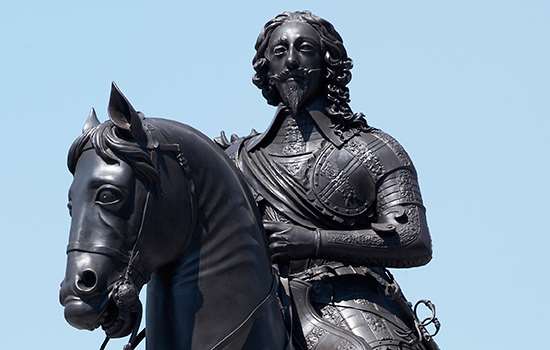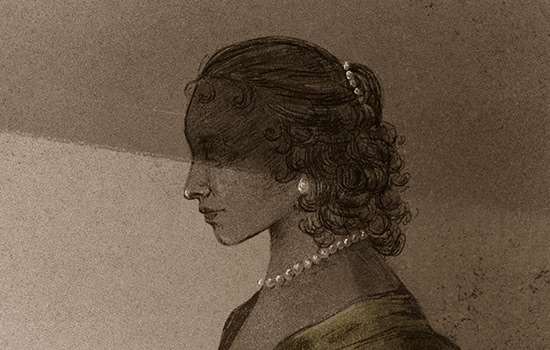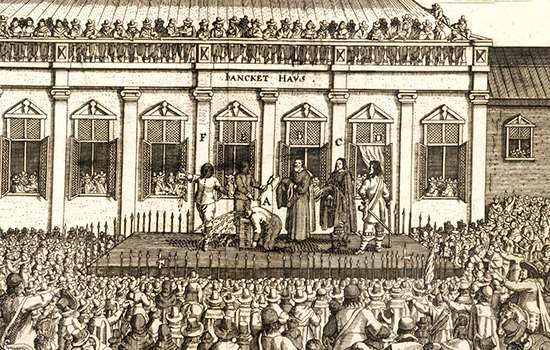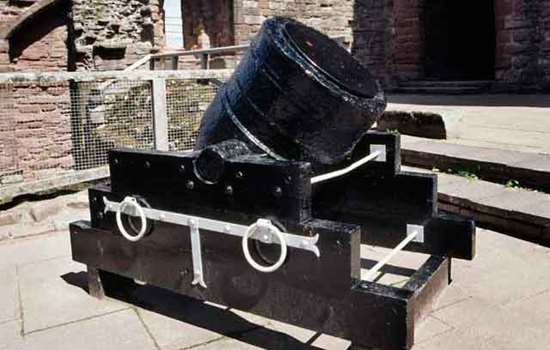The King takes flight
At the end of the First Civil War, although Charles was in custody he still had some freedom of movement and was able to negotiate about his political future. Opportunities arose for him to exploit rival factions in the English Parliament, and among the Scots who had played a prominent part in the war.
However, by November 1647 – almost a year and a half later – there was no settlement in prospect. Fearful that radical soldiers in the New Model Army were in control of Parliament, the king slipped away from what proved to be lax custody at Hampton Court, under cover of darkness. He was on the run, with no clear plan that we can detect today.
He arrived at Place House, Titchfield, the home of Thomas Wriothesley, 4th Earl of Southampton. His companions, John Ashburnham and John Berkeley, crossed the Solent to the Isle of Wight and brought its governor, Colonel Robert Hammond, back with them. There was some thought that the colonel was sympathetic to the Royalist cause, so the king went to the island to stay at Carisbrooke Castle, believing it would be a refuge. It turned out to be a prison.
The Captive King
Colonel Hammond was troubled by such an important charge. Though courteous to the king he wrote immediately to Parliament, informing his superiors of the king’s presence on the island. Charles was a prisoner again, albeit with some freedom of movement, but his gaoler was an officer in the very army that he had sought to avoid.
In December, negotiations for a political and religious settlement resumed. Charles held separate talks at Carisbrooke with commissioners from the English and Scottish parliaments. Secretly, he made an agreement with the Scots – known as the ‘Engagement’ – in which they pledged military and political support for Charles in return for religious reforms in England, including the establishment of the Presbyterian form of Protestantism.
Shortly afterwards, in January 1648, a small uprising in favour of the king took place in Newport on the island. It was easily suppressed but led to Charles’s freedom being curtailed – he was confined to the castle and not allowed any private audience or communication. His household staff was reduced to 30, his chaplains were dismissed and he was more closely watched. A bowling green was laid out for the king’s use in the outer ward of the castle.
Loyalty and Betrayal
Plans to effect Charles’s escape were made continuously by Royalist supporters and sympathisers on the island and mainland, via a secret courier network carrying letters written in elaborate cyphers. By 20 January, Colonel Hammond was advised to keep careful watch by the Derby House Committee, the joint English and Scots committee of Parliamentarian government, which had its own network of agents.
Charles’s household staff included Thomas Herbert and Henry Firebrace as grooms of the bedchamber, Anthony Mildmay as gentleman usher and Silius Titus as equerry. Firebrace and Titus were sympathetic to the king but others, including Mildmay, were not, so the loyalties of those who kept watch on the king varied. Such was the atmosphere of mistrust that two of them slept across the king’s bedchamber doors at night.
It was under such tense and duplicitous circumstances that coded letters were smuggled in and out of the castle, usually by servants, between the king, Royalist agents and apparent sympathisers who were plotting an escape. Some of them were almost certainly double agents and so, for the most part, Parliament knew something of the plans.
The escape manager on the outside was probably Jane Whorwood, a gentlewoman with widespread influential connections, especially in London and Edinburgh. She worked with Jane Wheeler who was a courier and for a time, they despatched and received letters to and from Charles via a servant, Mary (Lee), who looked after the king’s linen. Among Whorwood’s correspondents were John Ashburnham, who was often based at Netley Abbey near Southampton, and her uncle, William Hamilton, Earl of Lanark and one of Charles’s principal supporters in Scotland.
Whorwood suspected that there were informers in the network, notably John Loe, a merchant who offered ship transport. Also, the king often consulted William Lilly, a famous astrologer in London, either through coded letters, or through Jane Whorwood visiting in person. Strange as it may seem to us, astrologers were widely consulted and Lilly had a reputation of being able to see the future, so some escape plans were revealed to him. He almost certainly leaked them to Parliament.
Read more on Jane WhorwoodThe first escape attempt
The Scots were divided about the Engagement and it was not discussed in earnest until 7 March 1648, when they asked the English Parliament for the king’s release, to no effect. Meanwhile, plans for the king’s escape continued – in one instance, the king was to climb from his bedchamber into the room above and to cross in the roof space to an unguarded room, then out through a window.
The first actual escape attempt came on 20 March. The king tried to climb out of a window from which he would lower himself 10 feet (about 3 metres) on a silk cord into the unguarded castle courtyard. From there, he planned to escape via an outer bastion on the south side of the castle, where Henry Firebrace waited. However, he became lodged between an iron bar and the window frame, and could only retreat to his room, lighting a candle as the signal to Firebrace that the attempt had failed. Firebrace later noted that:
I gave the Signe, at the appointed tyme. His Majesty put himself forward, but then too late found himself mistaken; he sticking fast between his breast and shoulders... I heard him groane, but could not come to help him.
The Second Escape Attempt
The next try was a long time in the making. Planning involved the smuggling of a hacksaw and nitric acid into Carisbrooke to help the king loosen and remove a window bar. He would climb down and escape via the bowling green on the east side of the castle. Jane Whorwood chartered a ship; Henry Firebrace organised a boat for transport off the island; John Burroughs, a royal harbinger, arranged for horses. The plan was to take Charles to Portsmouth, then on to Arundel and finally to Queenborough on the river Medway, where Jane Whorwood was waiting to take him to Holland.
However, Derby House knew of the plot by 15 April, and Jane Whorwood and Henry Firebrace warned the king on the 23rd. At this time, Jane was at Queenborough aboard the ship she had arranged, watched by Parliamentary spies. Meanwhile, Colonel Hammond moved Charles to more confined quarters in the domestic wing against the north wall of the castle, which were more difficult to escape from.
On 19 May, John Ashburnham was arrested at Netley Abbey, where details of the escape plan were found. Nevertheless, on 29 May, the attempt began. Charles applied nitric acid to the bar and was working with the hacksaw, when Colonel Hammond walked into the room offering ‘to take leave of your Majesty, for I hear you are going away’. The king is said to have laughed in resignation: two sentries, bribed for their silence, had betrayed him at the last minute.
The Second Civil War
Charles failed to escape just as fighting began in the Second Civil War, which proved to be several uncoordinated uprisings in favour of the king. Fighting was bloody and merciless, nonetheless. In south Wales, a revolt was quickly beaten by Parliamentary soldiers in early May; similarly at Maidstone in Kent in late May and early June, and at Walmer, Deal and Sandown castles, where sieges continued until 5 September.
At Colchester in Essex, fighting began in June and dragged on as a siege until 28 August. Smaller risings occurred in Cornwall, north Wales, Northamptonshire, Lincolnshire, Yorkshire and Surrey though these were quickly put down by Parliament. And at long last, on 8 July, a Scots army honoured the Engagement and marched south through north-west England. Too late, ill prepared and half-hearted, the Scots were defeated at Preston on 17–19 August, surrendering to Parliamentary forces on the 25th.
Aftermath: No more chances
Astonishingly, Parliament agreed further talks with the king, who left Carisbrooke for negotiations at Newport on 15 September. These dragged on into November but were doomed to failure, as the Army hardliners had made up their minds to bring Charles to face their justice in London. Between 13 and 25 November, Jane Whorwood was in Newport and the means were in place for an escape, but the weary king dismissed any attempt.
As November turned to December, the king was taken to Hurst Castle, a lonely spot on the mainland opposite the Isle of Wight, where he remained in custody until the 19th. By this time, the Army had expelled all moderate MPs from the Commons on 6 December in what became known as Pride’s Purge. This left a much smaller body, the Rump Parliament, composed of the king’s implacable enemies.
Charles I’s running was over. He was put on trial in Westminster Hall and found guilty of attempting to ‘uphold in himself an unlimited and tyrannical power to rule according to his will, and to overthrow the rights and liberties of the people’. Sentenced to death, he was beheaded in Whitehall on 30 January 1649.
Find out more
-

The Civil Wars Explained
A comprehensive guide to the events of the Civil Wars. Learn about what caused the wars, how they unfolded, and what their legacy was.
-

CHARLES I
Read about the man at the centre of the most turbulent period of England’s history, and learn about the history of the statue dedicated to him in Trafalgar Square, London.
-

Jane Whorwood: Royalist Spy
Jane Whorwood was one of the key agents behind attempts to free Charles I from captivity on the Isle of Wight, notably from Carisbrooke Castle, in 1648.
-

THE ENGLISH CIVIL WARS: HISTORY AND STORIES
Discover how the Civil Wars unfolded at English Heritage’s properties – from ferocious sieges to the Isle of Wight castle where Charles I was held prisoner.
-

Charles II and the Royal Oak
Find out how the future king escaped from Parliamentarian forces after the Battle of Worcester in 1651, giving English history one of its greatest adventure stories.
-

The Civil Wars and the British Army
Discover how the reorganisation of the Parliamentarian army during the Civil Wars marked the beginning of the modern British Army tradition.
